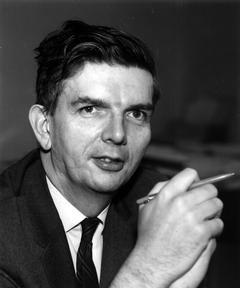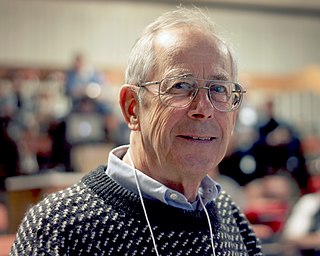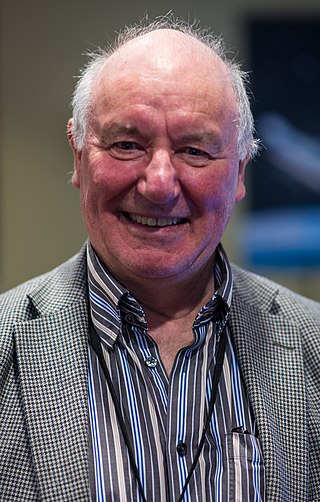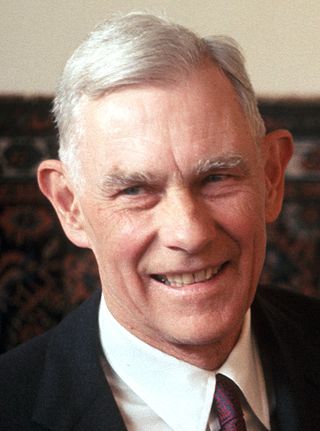
Aage Niels Bohr was a Danish nuclear physicist who shared the Nobel Prize in Physics in 1975 with Ben Roy Mottelson and James Rainwater "for the discovery of the connection between collective motion and particle motion in atomic nuclei and the development of the theory of the structure of the atomic nucleus based on this connection". His father was Niels Bohr.

Niels Henrik David Bohr was a Danish physicist who made foundational contributions to understanding atomic structure and quantum theory, for which he received the Nobel Prize in Physics in 1922. Bohr was also a philosopher and a promoter of scientific research.

Paul Adrien Maurice Dirac was an English mathematical and theoretical physicist who is considered to be one of the founders of quantum mechanics and quantum electrodynamics. He is credited with laying the foundations of quantum field theory. He was the Lucasian Professor of Mathematics at the University of Cambridge, a professor of physics at Florida State University and the University of Miami, and a 1933 Nobel Prize in Physics recipient.

The Niels Bohr Institute is a research institute of the University of Copenhagen. The research of the institute spans astronomy, geophysics, nanotechnology, particle physics, quantum mechanics, and biophysics.

Abraham Pais was a Dutch-American physicist and science historian. Pais earned his Ph.D. from University of Utrecht just prior to a Nazi ban on Jewish participation in Dutch universities during World War II. When the Nazis began the forced relocation of Dutch Jews, he went into hiding, but was later arrested and saved only by the end of the war. He then served as an assistant to Niels Bohr in Denmark and was later a colleague of Albert Einstein at the Institute for Advanced Study in Princeton, New Jersey. Pais wrote books documenting the lives of these two great physicists and the contributions they and others made to modern physics. He was a physics professor at Rockefeller University until his retirement.

John David Barrow was an English cosmologist, theoretical physicist, and mathematician. He served as Gresham Professor of Geometry at Gresham College from 2008 to 2011. Barrow was also a writer of popular science and an amateur playwright.

Geoffrey Ronald Burbidge (24 September 1925 – 26 January 2010) was an English astronomy professor and theoretical astrophysicist, most recently at the University of California, San Diego. He was married to astrophysicist Margaret Burbidge and was the second author of the influential B2FH paper which she led.

Robert Henry Dicke was an American astronomer and physicist who made important contributions to the fields of astrophysics, atomic physics, cosmology and gravity. He was the Albert Einstein Professor in Science at Princeton University (1975–1984).

Phillip James Edwin Peebles is a Canadian-American astrophysicist, astronomer, and theoretical cosmologist who is currently the Albert Einstein Professor in Science, emeritus, at Princeton University. He is widely regarded as one of the world's leading theoretical cosmologists in the period since 1970, with major theoretical contributions to primordial nucleosynthesis, dark matter, the cosmic microwave background, and structure formation.

Malcolm Sim Longair is a British physicist. From 1991 to 2008 he was the Jacksonian Professor of Natural Philosophy in the Cavendish Laboratory at the University of Cambridge. Since 2016 he has been Editor-in-Chief of the Biographical Memoirs of Fellows of the Royal Society.

Dennis William Siahou Sciama, was an English physicist who, through his own work and that of his students, played a major role in developing British physics after the Second World War. He was the PhD supervisor to many famous physicists and astrophysicists, including John D. Barrow, David Deutsch, George F. R. Ellis, Stephen Hawking, Adrian Melott and Martin Rees, among others; he is considered one of the fathers of modern cosmology.

David Mathias Dennison was an American physicist who made contributions to quantum mechanics, spectroscopy, and the physics of molecular structure.
In chemistry and atomic physics, an electron shell may be thought of as an orbit that electrons follow around an atom's nucleus. The closest shell to the nucleus is called the "1 shell" (also called the "K shell"), followed by the "2 shell" (or "L shell"), then the "3 shell" (or "M shell"), and so on farther and farther from the nucleus. The shells correspond to the principal quantum numbers (n = 1, 2, 3, 4 ...) or are labeled alphabetically with the letters used in X-ray notation (K, L, M, ...). A useful guide when understanding electron shells in atoms is to note that each row on the conventional periodic table of elements represents an electron shell.
David Favrholdt was a Danish philosopher, educated with M.A.s in psychology and philosophy and later Dr. Phil. from Copenhagen University. He is one of few Danes to be included in the International Who's Who.
The Roy G. Neville Prize in Bibliography or Biography is a biennial award given by the Science History Institute to recognize a biographical work in the field of chemistry or molecular science. The Roy G. Neville Prize was established in 2006 and named to honor scientist and book collector Roy G. Neville. Neville founded Engineering and Technical Consultants, Redwood City, California, in 1973. He also assembled one of the world's largest collections of rare books in the field of science and technology. The Neville collection, including over 6,000 titles from the late 15th century to the early 20th century, was acquired by the Chemical Heritage Foundation in 2004.

Licia Verde is an Italian cosmologist and theoretical physicist and currently ICREA Professor of Physics and Astronomy at the University of Barcelona. Her research interests include large-scale structure, dark matter, dark energy, inflation and the cosmic microwave background.
Klaus Mølmer is a Danish physicist who is currently a professor at the Niels Bohr Institute of the University of Copenhagen. From 2000 to 2022, he was a professor of physics at the University of Aarhus.
Tokio Takeuchi was a Japanese physicist.
Irene Tamborra is the Italian particle astrophysicist, specializing in the areas of neutrino astrophysics and cosmology as well as multi-messenger astronomy. She is professor of particle astrophysics at the Niels Bohr Institute, University of Copenhagen.
Nancy Elizabeth Weber Boggess was an astrophysicist known for her work in developing telescopes that were used in space by NASA.













